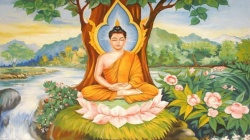Difference between revisions of "Chengde Shuxiang Si"
(Created page with " <poem> Chengde Shuxiang Si Shuxiang si 殊像寺 built by {{Wiki|Qianlong Emperor}} in the valley north of his Bishu shanzhuang 避暑山莊is one of the eight temple...") |
|||
| Line 1: | Line 1: | ||
| − | + | [[File:800 nlightenment.jpg|thumb|250px|]] | |
<poem> | <poem> | ||
| − | Chengde Shuxiang Si | + | [[Chengde Shuxiang Si]] |
| − | Shuxiang si 殊像寺 built by {{Wiki|Qianlong Emperor}} in the valley [[north]] of his Bishu shanzhuang | + | [[Shuxiang si]] [[殊像寺]] built by {{Wiki|Qianlong Emperor}} in the valley [[north]] of his [[Bishu shanzhuang]] [[避暑山莊]]is one of the eight [[temples]] on the outskirts of [[Chengde]] of the Heibei province. According to the records, after [[Wikipedia:emperor Qianlong|Qianlong]] accompanied his mother to [[Wutai shan]] [[五台山]], he decided to build a [[temple]] dedicated to [[Manjushri]]. Its architecture is based on a [[temple]] with the same [[name]] on [[Wutai shan]]. |
| − | The Shuxiang si in Chengde, just like the model it is based on in [[Wutai shan]], has a classical architectural [[appearance]]. Echoing [[Wikipedia:emperor Qianlong|Qianlong]] emperor’s proclamation that he was the [[reincarnation]] of [[Manjusri]], the [[bodhisattva’s]] statue in the Shuxiang si seemed to be a portrait of the [[emperor]] himself. | + | The [[Shuxiang si]] in [[Chengde]], just like the model it is based on in [[Wutai shan]], has a classical architectural [[appearance]]. Echoing [[Wikipedia:emperor Qianlong|Qianlong]] emperor’s proclamation that he was the [[reincarnation]] of [[Manjusri]], the [[bodhisattva’s]] statue in the [[Shuxiang si]] seemed to be a portrait of the [[emperor]] himself. |
| − | Something that set Shuxiang si apart from other [[monasteries]] was the fact that it was renowned for the [[scholarly]] work that was done there. It was truly a working [[monastery]] under the {{Wiki|imperial}} {{Wiki|patronage}}. | + | Something that set [[Shuxiang si]] apart from other [[monasteries]] was the fact that it was renowned for the [[scholarly]] work that was done there. It was truly a working [[monastery]] under the {{Wiki|imperial}} {{Wiki|patronage}}. |
Sources: | Sources: | ||
Revision as of 04:34, 26 February 2014
Chengde Shuxiang Si
Shuxiang si 殊像寺 built by Qianlong Emperor in the valley north of his Bishu shanzhuang 避暑山莊is one of the eight temples on the outskirts of Chengde of the Heibei province. According to the records, after Qianlong accompanied his mother to Wutai shan 五台山, he decided to build a temple dedicated to Manjushri. Its architecture is based on a temple with the same name on Wutai shan.
The Shuxiang si in Chengde, just like the model it is based on in Wutai shan, has a classical architectural appearance. Echoing Qianlong emperor’s proclamation that he was the reincarnation of Manjusri, the bodhisattva’s statue in the Shuxiang si seemed to be a portrait of the emperor himself.
Something that set Shuxiang si apart from other monasteries was the fact that it was renowned for the scholarly work that was done there. It was truly a working monastery under the imperial patronage.
Sources:
Anne Chayet. 2004. "Architectural Wonderland: An Empire of Fictions." In James Millward, et al. eds. New Qing Imperial History: The Making of Inner Asian Empire at Qing Chengde. pp. 33-52.
Philippe Forêt. 2000. Mapping Chengde: The Qing landscape enterprise. Honolulu: University of Hawai'i. 49-53, 116-138.
Entry by Agnes Lin
